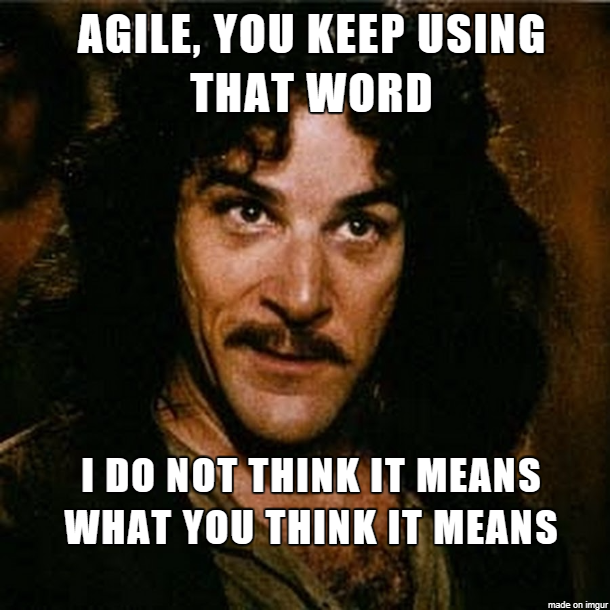Many posit that Agile was born at Snowbird 20 or so years ago, but Agile project management processes have existed in one form or another for a long, long time, nor is there one right way of implementing Agile. From the accounts I have read and people I have talked to, many use the aspects of Agile that work for them rather than applying it in its most distilled form.
This, IMO, is the most effective use of Agile. If you can’t customize a work process, how is your work prioritizing people over processes or results over documentation (supposedly the heart of Agile)?
In my past life, I worked as a costumer, among other theatrical positions. Since that time, theatrical management processes have pervaded my intuitive management philosphies. Come to discover, many of these are Agile processes. So, here are five Agile management processes I learned from the theatre.
1. User Centered Approach: Audience First
“Can you see it from the middle of the house?” is a question as inimical to theater as the phrase, “break a leg.” The house would be the theater, and the middle would be where the majority of the audience resides. So seeing things from the middle of the house refers to the practice of making sure the product is usable (in this case visible) by the greatest concentration of users.
“Seeing things from the middle of the house” refers to the practice of making sure the product is usable by the greatest concentration of users.
This user-centered approach is something that many other arts don’t practice nor is it always common practice among producers of products or services. Can you imagine an abstract artist wondering, as he circles his ginormous canvas dripping paint from a palette knife,* if the majority of canvas viewers will be able to see how even the drip patterns are from the vantage point of five feet in front of a museum wall?
I may also may have heard of the experience of a public relations rep who, having organized a press conference to showcase a new hospital, watched alongside the press with disbelief as hospital staff moved a patient bed into an elevator only to find that the elevators were not big enough to hold the hospital beds…
2. Frequent Iterations
The theatre has build, development, and testing process just like any other product or service. These iterations are seen in so many places throughout the theatre industry it’s almost dizzying.
Before a script is even licensed for a company to perform, it has already gone through multiple iterations and readings in front of audiences to hone its effect.
Every theatrical season offers more than one play with a run of generally a few weeks to a couple months, the response to which will then provide the producers with feedback in multiple areas:
- Audience response to a production topic/style
- Employee satisfaction with various designers, managers, and actors
- Audience engagement with particular actors
- Audience experience with the theatrical space or production studio
Every production is a chance for the producers to gain feedback and adjust their product to better achieve desired outcomes, whether that’s profit margin or refinement of production techniques.
3. Working with a Product Owner
The ultimate product owner can really be found in the theatrical (or film) producer. Their drive to see the product not just survive but thrive is no different than the passion and understanding a product owner usually exhibits in representing the intended audience or desired outcomes of their product to the production team.
A producer can have multiple productions going on at once or one main labor of love at any time. The producer works with directors, costume and technical managers, and designers, all of who are essentially extensions of the product owner, rather like the technical, functional, and business analysts on occasion used by an Agile product owner.
4. The Postmortem (aka Retrospective)
Retrospective or postmortem? I really like the term postmortem, but maybe it’s just ‘cause we use it in the theater? A well-conducted post-mortem (OR that most Agile of postmortems, the retrospective) is more than just a dissection of the production process and end product, it’s an evaluation of decisions and practices that worked well.
I did wonder why theatre has a post-mortem and everything else has a retrospective (or that most pedantic of phrases a “lessons-learned” evaluation). My theory is that it has something to do with the fact that medical autopsies and operations were once conducted in a space called an operating theater.
Due to the novelty of autopsies/operating procedures (and dare I say the drama?) and the interest they generated, early operations were often conducted in a gallery-style area constructed like a theater for public viewing and instruction. Technically, gallery style seating or theatrical seating was the original classroom/learning structure.^
Via this association, it’s clear why theatre has a postmortem rather than a retrospective.
5. Scalability
When you initially study or implement Agile practices, it’s difficult to think about it in use on a larger scale but having worked in the theatre with multiple productions in process at any one time involving multiple teams, processes using Agile are very, very scalable. It’s a bit like observing our solar system in action. You may think things will collide, but everything generally runs quite well or is altered (based on frequent feedback iterations and postmortems) to fit the needs for which it is being used.
While any aficionado of the theater can tell you there is generally a lot of drama no matter what the product, it’s also amazing that theatre has survived not only this long, but with a very intact and well-founded management structure.
Considering how many iterations have been conducted in the theatre just for the past 50 years, I’d say the industry has impressively honed management practices.
So if you ever want to spend some time truly working in an energetic, fast-paced, cutting edge industry, try the theatre. You might be surprised what you learn.
*A process used, in fact, by the artist Jackson Pollack https://www.sfmoma.org/jackson-pollocks-drip-painting-process/
^Follow that thought train a little further: What does that make theatre in its original form?




